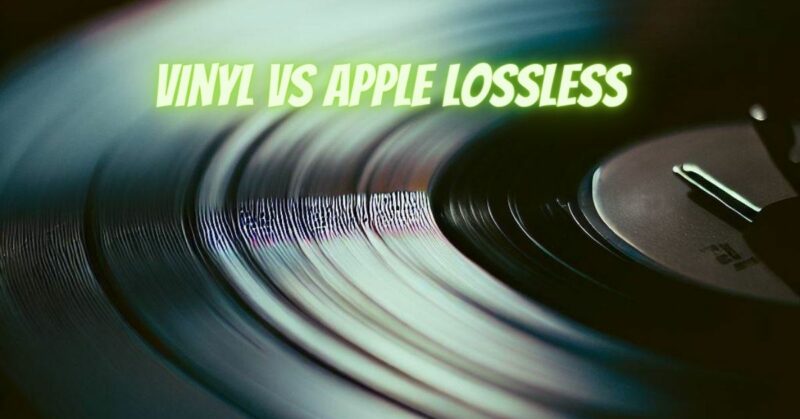When it comes to music formats, vinyl records and lossless digital formats like Apple Lossless have their own distinct characteristics and appeal. Vinyl represents the analog experience, while Apple Lossless focuses on high-quality digital audio. In this article, we will compare vinyl and Apple Lossless, discussing their unique qualities and considerations to help you make an informed choice.
Vinyl: Vinyl records have a loyal following and offer a unique listening experience. Here are some key points about vinyl:
- Analog Warmth and Character: Vinyl records are renowned for their warm, rich sound and unique analog character. The imperfections and natural compression of vinyl playback contribute to a distinctive listening experience that many enthusiasts appreciate. Vinyl can provide a sense of nostalgia and authenticity, bringing the music to life in a tangible way.
- Physical Engagement and Collectibility: Playing vinyl records involves a physical interaction, from handling the record to carefully placing it on the turntable and engaging with the album artwork and liner notes. Many collectors appreciate the tangible nature of vinyl, as well as the aesthetic value of album covers. Vinyl records are often sought after and collected for their rarity and value.
- Limitations and Maintenance: Vinyl does have limitations, such as susceptibility to wear and tear, potential surface noise, and the need for careful handling and maintenance. Records can be delicate and require proper cleaning, storage, and upkeep to maintain optimal sound quality. Additionally, vinyl production can be more expensive than digital formats, and the availability of certain albums may be limited.
Apple Lossless: Apple Lossless is a lossless audio format that offers high-quality digital audio reproduction. Here are some important aspects of Apple Lossless:
- Uncompressed Digital Audio: Apple Lossless, also known as ALAC (Apple Lossless Audio Codec), delivers audio in a lossless format, meaning it preserves the original audio data without any significant compression. This results in accurate and detailed sound reproduction, closely mirroring the quality of the original recording.
- Convenience and Accessibility: Apple Lossless allows for the convenience of digital music, offering instant access to a vast library of songs. It can be easily integrated into digital music ecosystems, such as Apple’s iTunes and Apple Music, allowing for seamless synchronization across devices and easy organization of your music library. Apple Lossless is also compatible with a wide range of audio players and streaming devices.
- Portability and Versatility: With Apple Lossless, you can enjoy high-quality audio on various devices, including smartphones, computers, and portable media players. The format supports metadata, allowing you to access track information, album art, and playlists. Additionally, Apple Lossless files take up less storage space compared to uncompressed formats like WAV, making it a practical choice for digital music collections.
Comparison and Considerations: When comparing vinyl and Apple Lossless, consider the following factors:
- Sound Preference and Experience: Vinyl offers a unique analog sound characterized by warmth and imperfections, while Apple Lossless provides a faithful reproduction of the original recording with high-quality digital audio. Consider your preference for the distinct qualities of analog versus the accuracy and clarity of lossless digital audio.
- Engagement and Collectibility: Vinyl records provide a tangible and interactive experience, appealing to collectors and those who appreciate the physical engagement of playing records. Apple Lossless prioritizes convenience, portability, and access to a vast digital music library.
- Cost and Availability: Vinyl records can be more expensive to collect and maintain, with limited availability for certain albums and potentially higher prices for rare or sought-after releases. Apple Lossless offers a wide selection of music at a more affordable and accessible price point.
| feature | Vinyl | Apple Lossless |
|---|---|---|
| Medium | Physical disc | Digital file |
| Sound quality | Some people believe that vinyl has a warmer, more natural sound than digital music. However, there is no scientific evidence to support this claim. | Apple Lossless offers lossless audio, which means that it is identical to the original master recording. |
| Durability | Vinyl is more susceptible to damage than digital music. If the disc is scratched or damaged, it may not play correctly. | Apple Lossless is a digital file, so there is no risk of damage to your music files. |
| Availability | Vinyl is becoming increasingly rare. However, there are still many collectors who enjoy listening to vinyl. | Apple Lossless is available through a variety of streaming services, including Apple Music and Tidal. |
| Price | Vinyl can be more expensive than Apple Lossless. However, there are also many affordable options available. | Apple Lossless is typically more affordable than vinyl. |
Conclusion:
Choosing between vinyl and Apple Lossless depends on your personal preferences, budget, and desired listening experience. Vinyl offers an analog warmth and engagement that appeals to collectors and those seeking a nostalgic experience. Apple Lossless provides the convenience, portability, and high-quality digital audio reproduction that suits modern digital music consumption. Ultimately, both formats have their own merits and can deliver enjoyable listening experiences.

